-
PDF
- Split View
-
Views
-
Cite
Cite
Claisa Andréa Silva De Freitas, Geraldo Arraes Maia, Paulo Henrique Machado De Sousa, Isabella Montenegro Brasil, Anália Maria Pinheiro, Storage stability of acerola tropical fruit juice obtained by hot fill method, International Journal of Food Science and Technology, Volume 41, Issue 10, December 2006, Pages 1216–1221, https://doi.org/10.1111/j.1365-2621.2006.01188.x
Close - Share Icon Share
Abstract
The present work aimed to evaluate the chemical, physicochemical, sensorial and microbiological changes of non-sweetened glass-bottled acerola tropical fruit juice processed by hot fill method stored for 350 days in the same conditions as market (28 ± 2 °C). At the end of the storage period, the juice presented good microbiological stability showing a reduction of the overall acceptance and appearance maintaining, however, the same initial acceptance concerning colour and flavour. The total soluble solid and SO2 were retained throughout the storage. The juice underwent a soft browning and an increase in pH was observed, while total carotenoids, anthocyanins and ascorbic acid suffered a slight decrease.
Introduction
The acerola fruit (Malpighia emarginata D.C.) has gained a great agricultural interest concerning the high vitamin C content and appearance, besides its wide industrial utilisation capacity. In this way, this fruit has attracted the fruitgrowers’ interest and is of great economical importance in many Brazilian regions (Nogueira et al., 2002). The major part of the acerola production is associated with agroindustrial sector (Coelho et al., 2003) because of the high perishability of fresh fruit (Carvalho, 2000).
The common market forms of acerola are the fresh fruit, frozen pulp and bottled juice (Yamashita et al., 2003).
The tropical fruit Brazilian industries processed around 34.40 thousand tons per year of acerola fruit, and it represents 7.16% of total processed fruits by these industries. This production is concentrated in the northeast region of Brazil (ASTN & APEX, 2001).
The acerola tropical fruit juice is a non-fermented beverage obtained from acerola pulp and dissolved in potable water by suitable technological process. This juice may be preserved by physical methods (heat) or chemical preservatives permitted by national fruit juice legislation or a combination of both processes. The juice must be diluted and sweetened before consumption according to industrial recommendations (Brasil, 2003).
The present work was conducted in order to evaluate the storage stability of non-sweetened acerola tropical fruit juice processed in a local fruit juice processing plant by the hot fill process in relation to chemical, physical–chemical, sensorial and microbiological changes during 350 days of storage in the same conditions as marketed.
Material and methods
Materials and processing
Acerola fruits (M. emarginata D.C.) were used in this study, and the fruits were harvested at firm-ripe stage from the metropolitan region of Fortaleza, CE, Brazil and transported in plastic boxes permeable to air immediately to the processing unit. The processing of non-sweetened acerola tropical fruit juice was carried out in an industry around the harvest area according to the fluxogram presented in Fig. 1.
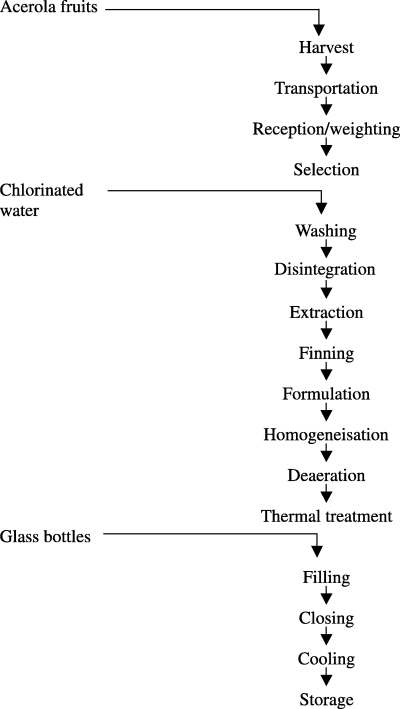
Processing of the non-sweetened acerola tropical fruit juice by hot fill method.
First, healthy, firm-ripe fruits without defects and of yellow and red colours was selected. Afterwards, the fruits were washed by immersion in chlorinated water and disintegrated by a press extractor to obtain the acerola pulp that was immediately formulated (water, 60% acerola pulp, sodium benzoate and sodium metabisulphite as preservatives and citric acid). After formulation, the juice was homogenised, deaerated and submitted to a heat treatment (90 °C per 60 s) following the hot filling (85 °C) in glass bottles (500 mL) and immediate closing using plastic roll-on caps. After closing, the bottles were cooled (30 °C), labelled and kept in pasteboard boxes at room temperature (28 ± 2 °C) for stability evaluation during 350 days of storage.
Chemical and physicochemical analyses
Three juice bottles were randomly selected immediately after processing (zero time) and in regular intervals of 50 days to calculate in triplicate the following: pH (AOAC, 1992), total soluble solids (in a table refractometer, model Analytikjena), total titratable acidity as citric acid, reducing sugars, non-reducing sugars and total sugars according to Instituto Adolpho Lutz (1985), colour (Rangana, 1997), vitamin C (Cox & Pearson, 1976), total anthocyanins (Francis, 1982), total carotenoids (Higby, 1962) and sulphur dioxide (AOAC, 1992).
Sensorial analyses
In sensory evaluation studies, a bottled juice was assessed on the basis of appearance, acceptance, taste and colour using a 9-point structured hedonic scale (Meilgaard et al., 1991). A score of 9 indicates ‘I liked it very much’, 5 ‘I did not like it and I did not reject it’ and 1 ‘I disliked it very much’. These analyses were carried out by 39 panelists. The beverage was first prepared by the dilution of 200 mL of the fruit juice into 1600 mL of mineral water according to the recommended dilution for the product and afterwards the juice was sweetened to 11 Brix using commercial sucrose.
Microbiological analyses
The microbiological analyses consisting of total coliforms, faecal coliforms, aerobic mesophilic bacteria, Salmonella sp., yeasts and moulds were carried out at zero time, 150, 300 and 350 days of storage using two juice bottles and according to APHA (2001) and Silva et al. (2001).
Statistical analysis
Analysis of regression was performed using the SAEG Program for Windows, version 8.X (Viçosa, Brazil). Significance was established at P ≤ 0.05 level.
Results and Discussion
Chemical and physicochemical analyses
The chemical and physicochemical analyses results are reported in Figs 2–10.
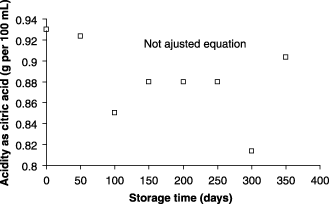

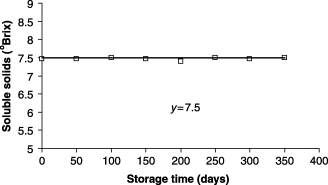
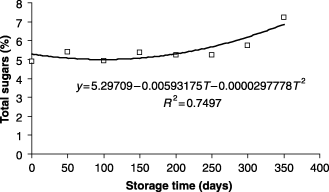
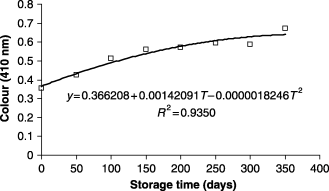
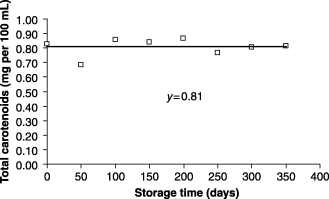
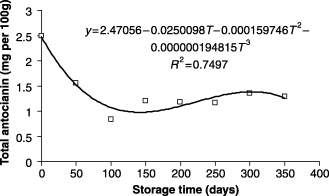
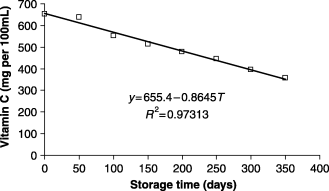
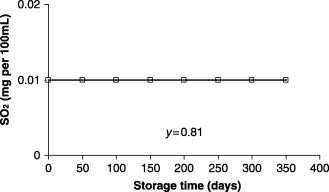
The total soluble solids, total titratable acidity and total sugars results are in agreement with the Brazilian legislation standard for non-sweetened acerola tropical fruit juice (Brasil, 2003), which establishes acceptable limits of 5 Brix, 0.80% of total acidity and maximum value of 8.5% for total sugars.
Anova showed significant difference in acidity, pH, total sugars, colour (410 nm), total anthocyanin and vitamin C (5% level of significance) throughout storage time.
Titratable acidity and pH
The juice showed a discrete increase in pH during the storage period, which can be attributed to citric acid loss in spite of the proximity of the total titratable acidity values at zero time to 350 days (Figs 2 and 3). A reduction of 3.23% in the initial acidity was observed at the end of the storage period. The pH values are similar to those obtained by Matsuura et al. (2002) in pasteurised frozen commercial acerola fruit juice. Carvalho & Guerra (1995) found a stable pH of 3.3 during 150 days of storage at room temperature (28 ± 2 °C) and also observed a reduction of acidity during the storage period.
Total soluble solids
The total soluble solids content did not change during the period of storage (Fig. 4). A stability of total soluble solid was observed by Carvalho & Guerra (1995) in glass-bottled commercial acerola tropical fruit juice during the storage at room temperature (28 ± 2 °C); Matta & Cabral (2002) in glass-bottled and polyethylene-terephthalate (PET)-clarified acerola tropical fruit juice under refrigeration temperature (4 °C) and Yamashita et al. (2003) in glass-bottled pasteurised and reconstituted acerola tropical fruit juice at room temperature.
Total sugars
A small variation in total sugar content of the juice was observed at the end of the storage period (Fig. 5). Carvalho & Guerra (1995) found the stability of the total sugars during 150 days of storage (28 ± 2 °C) in a glass-bottled juice and pasteurised acerola tropical fruit juice, and Maia et al. (2003) also observed the stability in a stored glass-bottled low-calorie beverage (25% of pulp) during 120 days at 25 °C.
Colour
During colour evaluation, an increase in absorbance was observed during the storage time showing a tendency of a non-enzymatic browning that can be verified visually (Fig. 6). Carvalho & Guerra (1995) detected the presence of dark pigments during 150 days of storage in glass-bottled pulpy and pasteurised acerola tropical fruit juice.
Total carotenoids and anthocyanins
The total carotenoids content found at zero time compared with that obtained during 350 days of storage showed a decrease of 3.61% (Fig. 7). The total carotenoids contents found is similar to that obtained by Porcu & Rodriguez-Amaya (2003) in three brands of bottled acerola juice. Carotenoids loss could be associated with a constant light exposition because of the nature of packing. Oxidation of carotenoids is one of the major causes of the carotenoids loss during the storage, which is accelerated by light, temperature and presence of metallic catalysts (Sarantópoulos et al., 2001).
The anthocyanin content was higher at zero time, and a reduction of 47.79% compared with the initial time was detected at the end of 350 days of storage (Fig. 8) This loss can be due to the interactions of anthocyanins and ascorbic acid and the packing material that is a transparent glass that allows the light incidence on anthocyanin.
The interaction of anthocyanin and ascorbic acid causes the degradation of both compounds leading to pigments loss and it occurs also in the presence of amino acids, phenols, sugars (Bobbio & Bobbio, 1995) and SO2. Therefore, the degradation of anthocyanin and ascorbic acid occurs simultaneously in the fruit juice. Anthocyanins are stable in acid pH (Eskin, 1990) and are in general unstable when exposed to visible or ultraviolet light and others forms of ionisation irradiation (Pereira & Baldwin, 1991).
Ascorbic acid
A reduction of 45.12% of ascorbic acid content was observed at the end of the storage (Fig. 9). It is known that for adults the vitamin C recommended daily ingestion (RDI) is 45 mg (FAO/WHO, 2001). It can be observed that at the end of 350 days of storage a 250 mL of diluted juice (1:8) provides 220% of this RDI, which characterises this juice as an excellent source of vitamin C.
The ascorbic acid loss level observed was higher compared with the data of Yamashita et al. (2003), which showed a loss of 32% ascorbic acid in the reconstituted and pasteurised acerola juice stored for 4 months. Carvalho & Guerra (1995) observed an ascorbic acid loss of 36.44% in pulpy acerola tropical fruit juice stored for 150 days at room temperature (28 ± 2 °C). Maia et al. (2003) detected an ascorbic acid reduction of 16.87% in a low-calorie acerola beverage stored for 120 days at 25 °C. Matta & Cabral (2002) observed that the ascorbic acid content in clarified acerola juice stored in PET bottles was preserved during the 90 days of storage under refrigeration temperature (4 °C). The results expressed the influence of temperature on the stability of ascorbic acid.
SO2
The initial SO2 result of 100 mg per 100 mL (100 ppm) was maintained unaltered throughout the storage period (Fig. 10). Considering that for ingestion the acerola tropical fruit juice must be diluted to 1:8, the values found were in accordance to the standard Brazilian legislation that allows a maximum limit of 0.004 g of SO2 per 100 mL of the ready-to-drink beverage (Brasil, 1999).
Microbiological evaluation
Microbiological analyses revealed that the juice after processing (zero time) and during 350 days of storage showed a total number of aerobic mesophilic bacteria, filamentous mould and yeasts lower than 10 CFU mL−1 and that the number of total coliforms and faecal coliforms were lower than 3 MPN (most probable number) per mL. The presence of Salmonella sp. was not detected in the evaluated samples. The investigated product is in good agreement with the present federal fruit juice standard legislation (Brasil, 2001). The microbiological analyses of this study confirmed the effectiveness of the thermal treatment in maintaining the quality of the juice throughout the storage period.
Sensorial evaluation
The sensorial evaluation results are shown in Figs 11–14. No significant differences (5% level of significance) were found during the storage time.
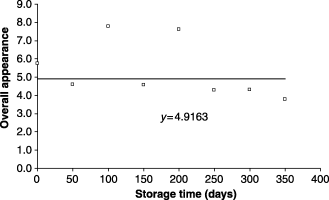


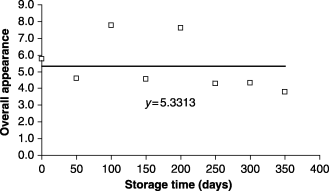
Little variations among the score average of colour acceptance at zero time, 50, 150, 300 and 350 days were observed, while the score average of taste acceptance was maintained stable during the 350 days of storage. Therefore, a decrease in the juice colour and taste acceptance at the end of the shelf life can be observed. The score average of overall acceptance showed little variations at zero time, 100, 150, 200 and 300 days; however, a smaller juice overall acceptance at the end of the storage period was observed.
Conclusions
The non-sweetened acerola tropical fruit juice processed by hot fill method maintained an adequate stability during the storage period.
At the end of 350 days of storage, the juice showed a reduction in the overall acceptance and appearance while maintaining the same initial colour and taste acceptance.
The stability of the total soluble solid and SO2 were maintained during the storage period. However, the juice developed a slight browning and an increase in pH can be observed, while the total carotenoids, anthocyanins and ascorbic acid suffered a significant reduction.



